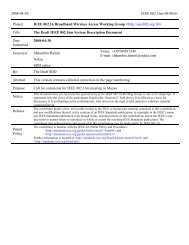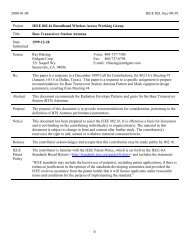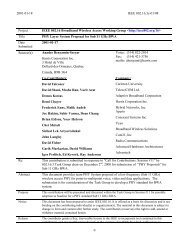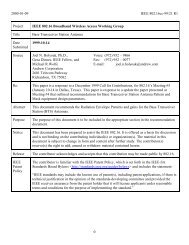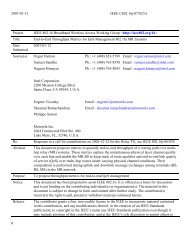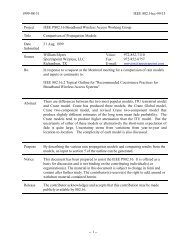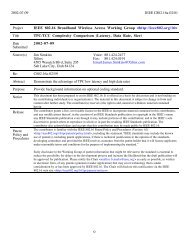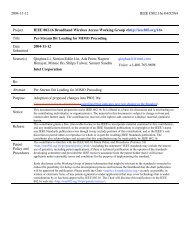802.16.1 Functional Requirements, Rev. 1 - LMSC, LAN/MAN ...
802.16.1 Functional Requirements, Rev. 1 - LMSC, LAN/MAN ...
802.16.1 Functional Requirements, Rev. 1 - LMSC, LAN/MAN ...
You also want an ePaper? Increase the reach of your titles
YUMPU automatically turns print PDFs into web optimized ePapers that Google loves.
123456789101112131415161718191999-12-17 IEEE 802.16s-99/00r12 <strong>802.16.1</strong> System ModelThis section presents a high level description of a system model to be used as a framework fordeveloping <strong>802.16.1</strong> protocol standards. The model describes some of the main features of an<strong>802.16.1</strong> system, and the terminology to be used by the 802.16 working group in the creation ofthe standards.As mentioned in section 1.1, an <strong>802.16.1</strong> “system” constitutes: an <strong>802.16.1</strong> MAC and PHYimplementation, in which at least one subscriber station communicates with a base station via aradio air interface (an <strong>802.16.1</strong> system), and services transported by the MAC and PHYprotocols. An <strong>802.16.1</strong> system employs point-to-multipoint (P-MP) radios operating in thevicinity of 30 GHz, but generally in the range from 10 GHz to 66 GHz, to connect a base stationto one or more subscriber stations [4][9]. Radio communications in the above range require lineof-sight(LOS) between a base station and subscriber station. LOS blocked by foliage alsocontributes heavily to signal attenuation. Figure 2-1 and Figure 2-2 [13] depict some typical<strong>802.16.1</strong> systems. <strong>802.16.1</strong> systems SHALL be multiple-cell frequency reuse systems. The rangeof <strong>802.16.1</strong> radios varies with transmit power, LOS blockage, availability requirement, andatmospheric conditions.202122Figure 2-1: System Showing a Base Station Mounted on a Tall Bulding-5-



